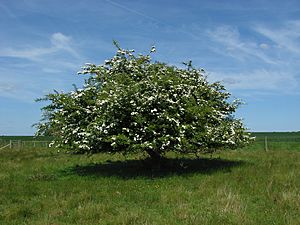Chawridge Bourne facts for kids
| Site of Special Scientific Interest | |
 |
|
| Area of Search | Berkshire |
|---|---|
| Interest | Biological |
| Area | 9.4 hectares (23 acres) |
| Notification | 1983 |
| Location map | Magic Map |
Chawridge Bourne is a special natural area in Berkshire, England. It covers about 9.4 hectares, which is roughly the size of 18 football fields! This site is protected as a Site of Special Scientific Interest because it's home to many important plants and animals.
A part of this area, called Chawridge Bank, is a nature reserve. It's about 5 hectares big and is looked after by the Berkshire, Buckinghamshire and Oxfordshire Wildlife Trust. They work hard to keep this natural space healthy for all its wildlife.
Contents
Exploring Chawridge Bourne's Nature
This long, narrow natural area gets its name from the stream, Chawridge Bourne, that flows through it. About half of the site is made up of natural grassland. This grassland is kept healthy by sheep that graze there, which helps different plants grow. You can also find areas with bushes (scrub) and woodlands filled with broad-leaved trees. On the eastern side, there's a very old hedge that marks a parish boundary. This hedge has many different kinds of trees growing in it.
Animals You Might Find
Chawridge Bourne is home to various animals. Here are some of the creatures that live there:
Tiny Mammals
- The harvest mouse (Micromys minutus) is a very small mouse that builds its nests high up in tall grasses.
Birds in the Sky
- The skylark (Alauda) is known for its beautiful song, often heard while it flies high above the fields.
- The great spotted woodpecker is a colorful bird that pecks at trees to find insects.
- The Eurasian blackcap is a small songbird with a distinctive black cap on its head.
- The lesser whitethroat is another small bird, often heard singing from dense bushes.
Busy Insects
- The common blue butterfly (Polyommatus icarus) is a lovely blue butterfly often seen fluttering over the grasslands.
- The dingy skipper (Erynnis tages) is a small, brown butterfly that looks a bit like a moth.
- The grizzled skipper (Pyrgus malvae) is another small butterfly with a checkered pattern on its wings.
Plants and Trees of the Area
The site is rich in different types of plants and trees.
Common Trees
- Hawthorn (Crataegus monogyna) is a common thorny tree with white flowers.
- Blackthorn (Prunus spinosa) has dark bark and produces small, tart fruits called sloes.
- Ash tree (Fraxinus) is a tall tree with distinctive leaves.
- Maple trees are known for their lobed leaves.
- English oak (Quercus robur) is a large, strong tree, very common in Britain.
- Wild apple (Malus sylvestris) is the ancestor of our cultivated apple trees.
- Wild service tree (Sorbus torminalis) is a less common tree with lobed leaves and small, brownish fruits.
Wild Plants and Flowers
- False oat-grass (Arrhenatherum elatius) is a tall grass often found in meadows.
- Yorkshire fog (Holcus lanatus) is a soft, velvety grass.
- Cock's-foot (Dactylis glomerata) is a common grass with a distinctive flower head.
- Tufted hairgrass (Deschampsia cespitosa) forms dense tussocks.
- Red fescue (Festuca rubra) is a fine-leaved grass.
- Sneezewort (Achillea ptarmica) has white, daisy-like flowers.
- Dyer's greenweed (Genista tinctoria) is a plant with bright yellow flowers.
- Meadow barley (Hordeum secalinum) is a type of wild barley.
- Adder's-tongue fern (Ophioglossum vulgatum) is a small, unusual fern.
- Cowslip (Primula veris) is a beautiful yellow wildflower that blooms in spring.
- Pepper-saxifrage (Silaum silaus) is a plant with yellow flowers.
- Hoary ragwort (Senecio erucifolius) has bright yellow flowers.
- Pale sedge (Carex pallescens) is a type of grass-like plant.
- Creeping cinquefoil (Potentilla anglica) has yellow flowers and spreads along the ground.
- Devil's-bit scabious (Succisa pratensis) has purple-blue flowers.
- Goldilocks buttercup (Ranunculus auricomus) is a type of buttercup.
- Hart's-tongue fern (Phyllitis scolopendrium) has long, strap-like leaves.
- Soft shield fern (Polystichum setiferum) is a delicate-looking fern.
- Common knapweed (Centaurea nigra) has purple, thistle-like flowers.
- Lesser hawkbit (Leontodon taraxacoides) has yellow, dandelion-like flowers.

